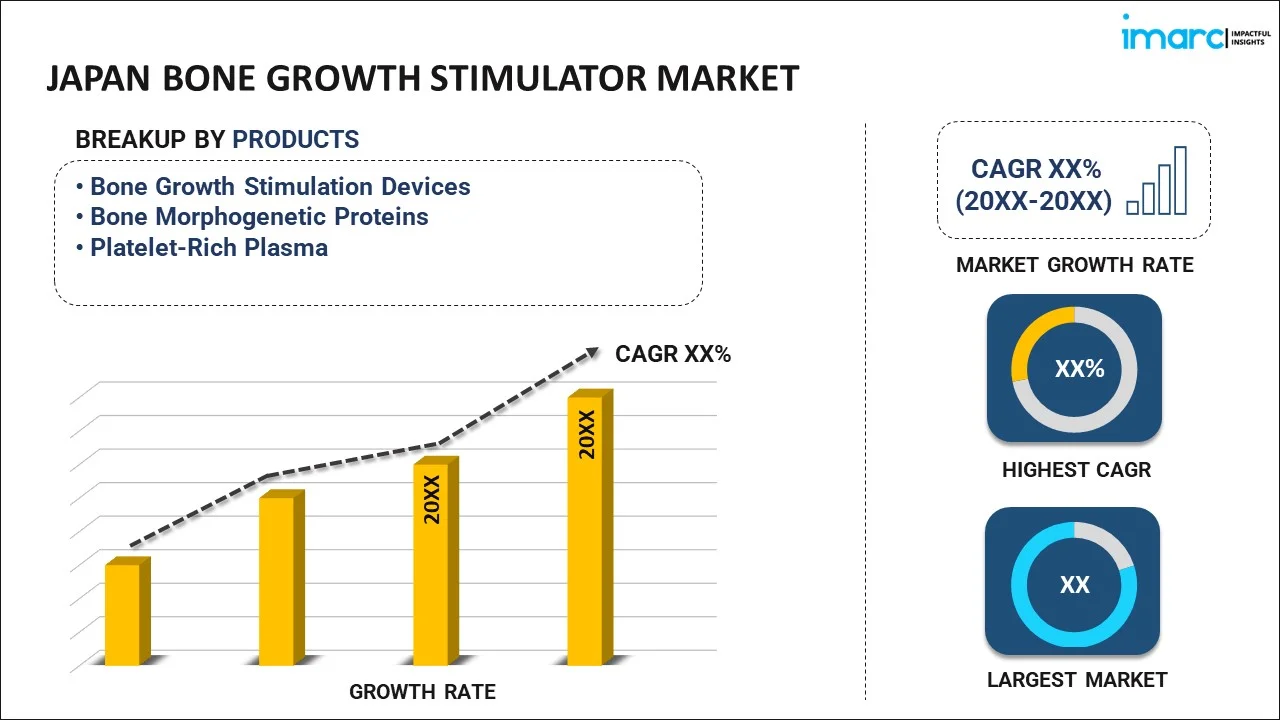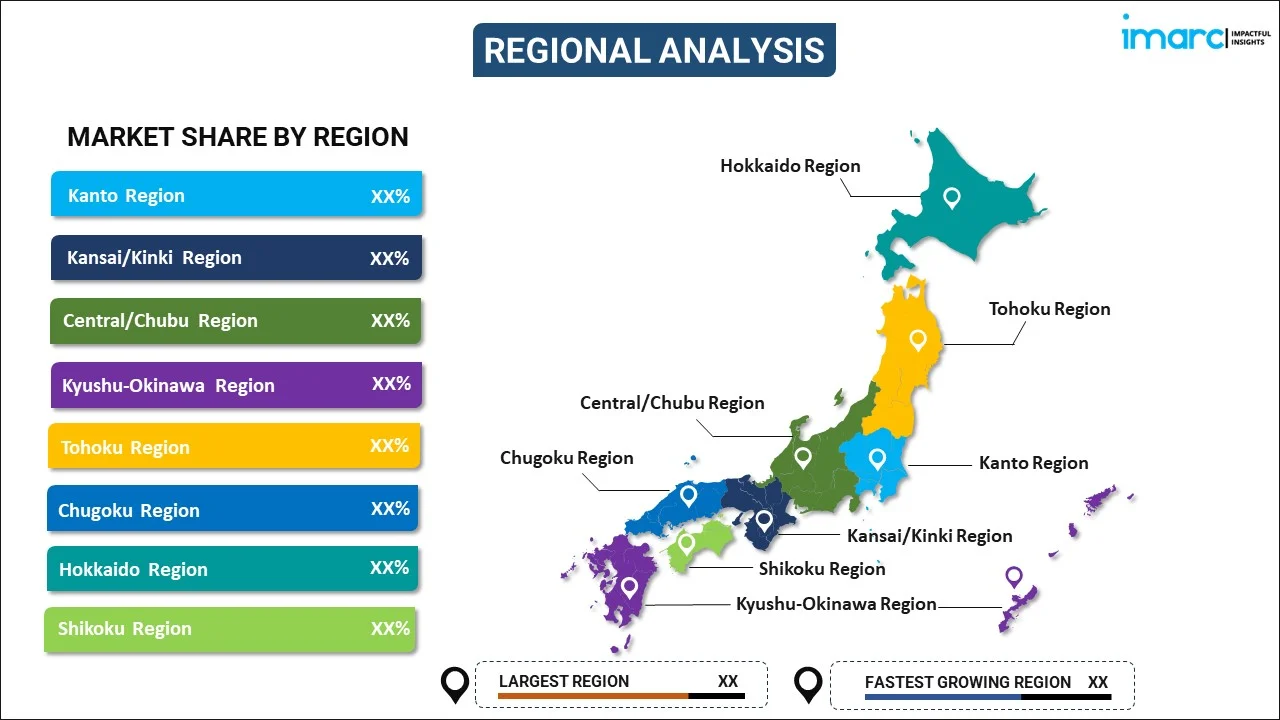
Japan Bone Growth Stimulator Market Report by Product (Bone Growth Stimulation Devices, Bone Morphogenetic Proteins, Platelet-Rich Plasma), Application (Spinal Fusion Surgeries, Delayed Union and Nonunion Bone Fractures, Oral and Maxillofacial Surgeries, and Others), End User (Hospitals and Clinics, Home Care, and Others), and Region 2025-2033
Market Overview:
Japan bone growth stimulator market size reached USD 73.7 Million in 2024. Looking forward, IMARC Group expects the market to reach USD 121.4 Million by 2033, exhibiting a growth rate (CAGR) of 5.2% during 2025-2033. The increasing cases of orthopedic conditions such as fractures and osteoporosis, and the unmet medical need for bone growth stimulators to treat these disorders, is driving the market.
|
Report Attribute
|
Key Statistics
|
|---|---|
|
Base Year
|
2024 |
|
Forecast Years
|
2025-2033
|
|
Historical Years
|
2019-2024
|
| Market Size in 2024 | USD 73.7 Million |
| Market Forecast in 2033 | USD 121.4 Million |
| Market Growth Rate (2025-2033) | 5.2% |
A bone growth stimulator is a medical device or treatment designed to promote and accelerate the natural healing and regrowth of bone tissue. It is commonly used in cases of bone fractures that are slow to heal or in situations where there is a need for enhanced bone growth, such as after spinal fusion surgery or for treating non-union fractures. Bone growth stimulators work through various mechanisms, including electromagnetic fields, ultrasound waves, or electrical currents, which are applied directly to the affected area. These stimuli encourage the body's natural processes of bone formation by increasing blood flow, stimulating cellular activity, and enhancing the production of osteoblasts, the cells responsible for building new bone. The use of bone growth stimulators can reduce the healing time for fractures, improve bone density, and enhance overall bone health. They are typically prescribed by orthopedic specialists and may be administered through wearable devices, implantable devices, or in-office treatments, depending on the patient's specific condition and needs. While they can be a valuable tool in orthopedic medicine, their effectiveness may vary depending on the individual and the type of injury.
Japan Bone Growth Stimulator Market Trends:
The bone growth stimulator market in Japan is poised for substantial growth in the coming years, primarily due to several key drivers that underscore its expanding significance in the healthcare industry. To begin with, the increasing incidence of bone fractures and orthopedic conditions is a pivotal factor propelling the market forward. As the regional population ages, the prevalence of conditions such as osteoporosis and osteoarthritis is on the rise, necessitating effective bone healing solutions. Moreover, technological advancements in medical devices and the growing acceptance of non-invasive treatment options have fueled the adoption of bone growth stimulators. These devices offer a less intrusive and more convenient alternative to traditional surgical interventions, appealing to both patients and healthcare providers. Additionally, the rising demand for accelerated healing and reduced recovery times, especially among athletes and sports enthusiasts, is driving the market's growth further. Furthermore, an increasingly health-conscious population is actively seeking methods to enhance their overall well-being, making bone growth stimulators an attractive option for individuals looking to expedite the healing process. As a result, the convergence of these factors is expected to continue driving the bone growth stimulator market, fostering innovation, and expanding its reach across various healthcare sectors.
Japan Bone Growth Stimulator Market Segmentation:
IMARC Group provides an analysis of the key trends in each segment of the market, along with forecasts at the country level for 2025-2033. Our report has categorized the market based on product, application, and end user.
Product Insights:

- Bone Growth Stimulation Devices
- Bone Morphogenetic Proteins
- Platelet-Rich Plasma
The report has provided a detailed breakup and analysis of the market based on the product. This includes bone growth stimulation devices, bone morphogenetic proteins, and platelet-rich plasma.
Application Insights:
- Spinal Fusion Surgeries
- Delayed Union and Nonunion Bone Fractures
- Oral and Maxillofacial Surgeries
- Others
A detailed breakup and analysis of the market based on the application have also been provided in the report. This includes spinal fusion surgeries, delayed union and nonunion bone fractures, oral and maxillofacial surgeries, and others.
End User Insights:
- Hospitals and Clinics
- Home Care
- Others
The report has provided a detailed breakup and analysis of the market based on the end user. This includes hospitals and clinics, home care, and others.
Regional Insights:

- Kanto Region
- Kansai/Kinki Region
- Central/ Chubu Region
- Kyushu-Okinawa Region
- Tohoku Region
- Chugoku Region
- Hokkaido Region
- Shikoku Region
The report has also provided a comprehensive analysis of all the major regional markets, which include Kanto Region, Kansai/Kinki Region, Central/ Chubu Region, Kyushu-Okinawa Region, Tohoku Region, Chugoku Region, Hokkaido Region, and Shikoku Region.
Competitive Landscape:
The market research report has also provided a comprehensive analysis of the competitive landscape in the market. Competitive analysis such as market structure, key player positioning, top winning strategies, competitive dashboard, and company evaluation quadrant has been covered in the report. Also, detailed profiles of all major companies have been provided.
Japan Bone Growth Stimulator Market Report Coverage:
| Report Features | Details |
|---|---|
| Base Year of the Analysis | 2024 |
| Historical Period | 2019-2024 |
| Forecast Period | 2025-2033 |
| Units | Million USD |
| Scope of the Report | Exploration of Historical and Forecast Trends, Industry Catalysts and Challenges, Segment-Wise Historical and Predictive Market Assessment:
|
| Products Covered | Bone Growth Stimulation Devices, Bone Morphogenetic Proteins, Platelet-Rich Plasma |
| Applications Covered | Spinal Fusion Surgeries, Delayed Union and Nonunion Bone Fractures, Oral and Maxillofacial Surgeries, Others |
| End Users Covered | Hospitals and Clinics, Home Care, Others |
| Regions Covered | Kanto Region, Kansai/Kinki Region, Central/ Chubu Region, Kyushu-Okinawa Region, Tohoku Region, Chugoku Region, Hokkaido Region, Shikoku Region |
| Customization Scope | 10% Free Customization |
| Post-Sale Analyst Support | 10-12 Weeks |
| Delivery Format | PDF and Excel through Email (We can also provide the editable version of the report in PPT/Word format on special request) |
Key Questions Answered in This Report:
- How has the Japan bone growth stimulator market performed so far and how will it perform in the coming years?
- What has been the impact of COVID-19 on the Japan bone growth stimulator market?
- What is the breakup of the Japan bone growth stimulator market on the basis of product?
- What is the breakup of the Japan bone growth stimulator market on the basis of application?
- What is the breakup of the Japan bone growth stimulator market on the basis of end user?
- What are the various stages in the value chain of the Japan bone growth stimulator market?
- What are the key driving factors and challenges in the Japan bone growth stimulator?
- What is the structure of the Japan bone growth stimulator market and who are the key players?
- What is the degree of competition in the Japan bone growth stimulator market?
Key Benefits for Stakeholders:
- IMARC’s industry report offers a comprehensive quantitative analysis of various market segments, historical and current market trends, market forecasts, and dynamics of the Japan bone growth stimulator market from 2019-2033.
- The research report provides the latest information on the market drivers, challenges, and opportunities in the Japan bone growth stimulator market.
- Porter's five forces analysis assist stakeholders in assessing the impact of new entrants, competitive rivalry, supplier power, buyer power, and the threat of substitution. It helps stakeholders to analyze the level of competition within the Japan bone growth stimulator industry and its attractiveness.
- Competitive landscape allows stakeholders to understand their competitive environment and provides an insight into the current positions of key players in the market.
Need more help?
- Speak to our experienced analysts for insights on the current market scenarios.
- Include additional segments and countries to customize the report as per your requirement.
- Gain an unparalleled competitive advantage in your domain by understanding how to utilize the report and positively impacting your operations and revenue.
- For further assistance, please connect with our analysts.
 Inquire Before Buying
Inquire Before Buying
 Speak to an Analyst
Speak to an Analyst
 Request Brochure
Request Brochure
 Request Customization
Request Customization




.webp)




.webp)












